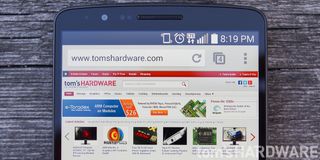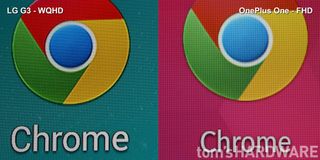LG G3 Smartphone Review: A Plethora Of Pixels And A Laser!
The LG G3 combines cutting-edge hardware, including a 5.5-inch WQHD screen and laser autofocus system, with a lightweight body and slim bezels to create a phone that was ahead of its time. Is it still worth your consideration? Read on for our impressions.
Why you can trust Tom's Hardware
The WQHD Screen In Detail
We ran a series of comprehensive tests on the G3’s screen to find out how it compares to some other phones. But first we want to cover the matter of its WQHD resolution in a little more detail.

The big question: is there any visible benefit associated with such a high resolution on a 5.5-inch phone screen? If you look at the pixel density values in the specification table, it’s apparent that the G3’s 534 PPI is the highest of any phone currently available in the North American market. It is substantially sharper than the 1080p screens found in most current smartphones, and due to its smaller size, is even sharper than the WQHD displays in the Note 4 and Nexus 6. So, does this have any experiential impact?

Well, at first glance no, since in most cases 1080p smartphone screens are already sharp, and you’d be hard pressed to see the difference unless you look closely. Apple correctly claims that when viewing a screen from 12 inches away, anything higher than 300 PPI makes the individual pixels invisible to the human eye. At this distance, looking at the 5.5-inch 1080p screen on the OnePlus One and the 1440p screen on the G3, they're hard to tell apart.

However, looking closely at the images above, which show fine detail of the minute lines in the clock icon and small text on a website, we see a small, but tangible, benefit to having such a high-resolution screen. The tiniest fonts are still hard to read on a 5.5-inch screen when viewing from 12 inches, requiring you to bring the phone closer to your face. That's when you’ll see a noticeable benefit from the G3’s WQHD screen.
Jumping from 1080p to 1440p is not nearly as noticeable as the move from 720p to 1080p. There are also some negatives to having a WQHD screen on your phone, which are quantified in the benchmark section (at least if it’s powered by a Snapdragon 801 or equivalent SoC and a battery capacity that isn’t any greater than phones with 1080p screens).
In an effort to minimize the power impact of the WQHD screen, LG implements what it calls 3A technology, which includes adaptive frame rate, adaptive clocking and adaptive timing control. While we were not able to perform any comparative tests on how these technologies affect the screen’s performance, the adaptive clocking does appear to alter the refresh rate dynamically. Unfortunately, while this is not noticeable 99% of the time, it does mean that animations and transitions on the G3’s 1440p screen just don’t feel as smooth as those on other flagships. You might not be as sensitive to the effect though, and it's most apparent when you are comparing phones side-by-side.
Another issue with the G3’s screen relates to software, and it seems only to affect particular builds on select versions of the G3. LG applies additional sharpening to content displayed on the screen, probably in an effort to make low-res assets look better on the high-res display. Unfortunately, if a filter like this is used too aggressively, it can have an adverse effect on image quality, causing halos to appear around some of the content being displayed. We weren’t able to capture a photographic example, but there are many to be found in some of the threads about this issue over on xda developers.
The problem is not as apparent on the Korean model we tested, but was noticeable on the ROM installed on the North American G3 when we first received it. Thankfully, subsequent software updates seemed to reduce the sharpening to a degree, but it isn't gone completely. It would be nice if LG allowed users to turn this on or off. Since the company hasn’t addressed the issue months after the G3’s release, the Android community has come to the rescue. A fix was recently issued, which requires flashing a new kernel.

Our testing also revealed that the G3’s screen is not as bright as some of the other flagship smartphones. This is most likely due to the excessive amount of heat and battery drain the WQHD display would generate if its backlight were allowed to push brightness above 400 nits, which other flagships can achieve. In fact, if you leave it at 100% brightness too long, the software automatically lowers it to 95%, and won't allow you to set maximum brightness until the screen cools down.
Since screen brightness above 400 nits isn’t required for general indoor use, this shortcoming doesn’t impact most environments. However, when using a phone outside, especially under sunlight, the screen needs to be as bright as possible. Sadly, the G3’s screen, even at maximum, just isn’t bright enough to make it easily readable in these conditions.
Another odd behavior is an auto-dimming mechanism when configuring screen brightness in manual mode. Whatever level you set seems to be gradually dimmed approximately 15% by the software over the span of about five minutes. The effect is gradual and not a huge change, so as not to be perceptible, but rather designed to conserve a little bit of power if you set the screen brighter than it really needs to be. While this could be considered a feature, it makes testing the phone a pain, since the battery testing requires a constant brightness setting. Like the sharpening “feature”, it would have been nice if LG included an option to toggle this on or off.
Current page: The WQHD Screen In Detail
Prev Page LG G3 Software Tour Next Page Call Quality And Audio PerformanceStay on the Cutting Edge
Join the experts who read Tom's Hardware for the inside track on enthusiast PC tech news — and have for over 25 years. We'll send breaking news and in-depth reviews of CPUs, GPUs, AI, maker hardware and more straight to your inbox.
-
Vorador2 At this point, i wouldn't bother. Rumors have surfaced than a successor will be launched in March.Reply
Tom's, you're almost at the point of self-parody. I would rename the site to "The Slowest Authority on Tech" -
wtfxxxgp For once I must agree that THW has dropped the ball on a very important phone review - it was too late - and the "better late than never" gesture never applies to a Review of something. My sister has just purchased this phone a week ago, had I had sight of a THW review then I'm sure I could have convinced her to rather wait for the next model that would surely have better support for that gorgeous screen - I played with it, it really is amazing watching video on that thing.Reply -
zodiacfml It's quite late and learned little except the voice activated shutter feature. Most of the information are subjective and benchmarks are quite of little use since the database is quite few.Reply
Tom's, here is a suggestion. Since you're good with gaming benchmarks, why not just make reviews of smartphones as portable gaming machines? There's plenty of information to be gathered from such and plenty of debates/discussion could be created just from that.
Build a database of old games and phones to be compared to new devices. Higher benchmark numbers encourages upgrades (*wink*). -
Cryio Absolutely no Lumia in the photo shoot comparison? I thought. A Lumia 1020 or Lumia 930 with Denim should have photo sampling comparisons in the next list. Also an iPhone 6+.Reply -
bujcri Suprised not to be mentioned about LG's Lollipop update for LG G3. At least worth mentioning that this update pretty much ruined some funtions on G3 like silent mode (now DND) and brought a lot of useless notifications on lockscreen like for example whatever you wanna have permanently on the notification bar (I used to have the date there). In a nutshell I really hate Lollipop.Reply -
kiniku I sold this phone on Ebay and bought a Sony Xperia Z3. I went from 8-10 hours of battery life to 48+, brighter screen, water resistant, and amazing sound.Reply -
glasssplinter I had to look at this article several times to confirm that you really just published this. New phone models are just around the corner and you're barely pushing this article out. Why did you feel the need to compare so many features to crapple tech also? The whole reason I'm interested in the phone is because it isn't crapple so people don't care how it stacks up. We want to know how it compares to other android phones. It's like putting the newest icrap review out and then saying but the icrap 10 still doesn't have a removable battery but this android and windows phone does in some hope of swaying them. Tom's has hit new lows...you would have been better off just not publishing this.Reply -
MobileEditor ReplyMan! I can't wait for the new Samsung Galaxy S4 review!
Don't buy it. Review done :)
- Matt H.
